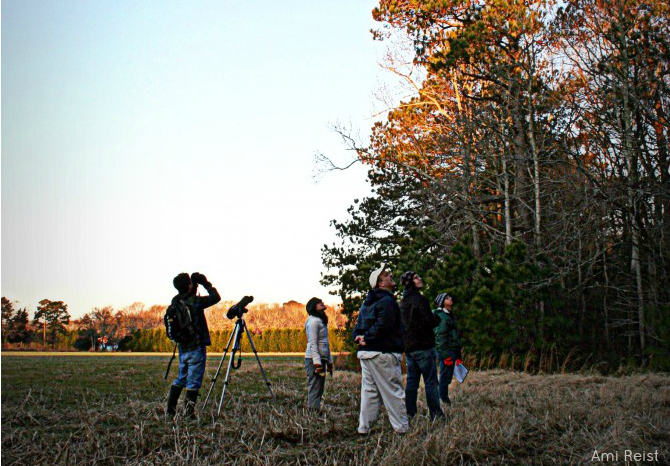The Delmarva Peninsula possesses an extensive variety of environments, including islands, tidal wetlands, swamps, fields and primeval forests. More than 400 bird species have been recorded in this region over the past 10 years. Birding is a longtime hobby of many eco-enthusiasts and wildlife conservationists that call the Eastern Shore home.
Birders can make an incredibly lasting impact and an important statement about the economic values of the area. Their goal is to help birds by promoting awareness towards select species and saving their habitats. This past week, a large group of birders gathered to participate in the Christmas Bird Count, a national tradition.
History
The Christmas Bird Count originated on Christmas Day in 1900. Before the bird count there was a bird hunt; groups of men would wallow into the woods to see how many animals they could kill – most were birds. The National Audubon Society developed a safer, less harsh activity to interest those who were unsettled about hunting game on or after the holiday. In 1900, 25 bird counts were recorded across the United States and Canada. Every year after, birders have been counting and identifying bird species during the Christmas Bird Count.
All Christmas Bird Counts are conducted annually between December 14th and January 5th. Educated volunteers comb regional lands searching for birds on foot, by vehicle, or by watching bird feeders. With binoculars, cameras, scopes, and modern phone apps that play bird calls, volunteers count birds as they migrate south for the winter.
The data collected during the bird count is vital for bird conservation. Trends, like which birds are currently living on the Eastern Shore and those who have disappeared over the years, are noted by the study. Roughly 10 groups of birders – that included nearly 100 bird fanatics from the central east coast – counted birds along the Pocomoke River, in Berlin, Ocean City, South Point, and along Assateague Island’s coast.
Bird Count
On Wednesday, December 28th, a group of 6 local birders met at the Assateague Market at 7 am. Led by Jim Rapp, a director of the Lower Shore Land Trust and outreach coordinator at the Assateague Coastal Trust, and Dave Wilson, executive director of the Maryland Coastal Bays Program, the group set forth into the woods of South Point with binoculars in hand. The goal was to begin on Porfin Drive at the Nichols’ property and travel south towards Assateague crossing field, forest, marsh, and bayside lands.
In a grassy, shallow pond man-made for duck hunting one, then two, then four more American Coots were spotted. The coot is a duck-like black and white bird that lives in marshy areas and has lobed toes, not webbed feet. Also noted in the pond and added to the tally sheet? Four ‘woodys’ and one drake. The Wood Duck is common to the area and the males have striking, colorful, iridescent plumage on their heads.
No sooner had Rapp finished focusing his magnified scope on the marshy pond ducks, then Wilson took off running through the ankle-high grass.
“A snipe! A snipe! A Wilson’s snipe!” he exclaimed as he darted towards a soggy section of land under a dead tree. The snipe is an unmistakable shorebird with a long, dark, skinny bill, mottled body coloring, and white-tipped wings.
“You know those birds are named after me, right?” Wilson joked with the group after identifying 6 snipes in total.
From sunrise to sunset, the South Point Team dealt with howling west-north-west winds gusting up to 30 mph. Rain boots made it easy to combat the saturated and puddled private properties that provide the perfect home for birds. Walking along forest and field edges, the group stirred flocks, stopped to identify, circled a small pond, and identified more than 60 different species of birds throughout the day.
“I haven’t been birding as much as I’d like to lately. I’m trying to identify as many species as I can,” Brooks Onley said humbly. Onley, who grew up in the Pocomoke area, has been birding locally since 2005. After easily identifying a group of over 50 Yellow-Rump Myrtle Warblers and a single Killdeer, the Christmas Bird Count seemed to jog Olney’s birding memory.
Local nature-lover, Tracy Lind, was extremely excited when she saw 13 White Pelicans fly 120 feet overhead. They were hand-written into the ‘rarities’ column on the tally sheet. Species not listed on the 160+ list of designated area birds but noted in the field must be written in with additional details or substantiating information about location, behavior, or patterns.
Due to a mild winter season thus far and not many cold snaps, some species haven’t flown south. The huge powerful Snow Owl is one species that has been sighted in our area several times recently. Juvenile Snow Owls have been traveling down the coast more frequently than in previous years.
“It’s a good year for Snow Owls. Up north, there has been a huge increase in the owl populations. There are too many owls and not enough food or territory for them to survive. That’s why we’re seeing so many in coastal Maryland,” said Rapp, “I’d love to see one.”
Highlights from the day that the South Point Team tallied were one mature Bald Eagle and six immature Eagles, a North Pintail, a lone Red-Tailed Hawk, one Screech Owl, and a pair of Great Horned Owls. Wilson was really excited to have seen a Merlin, a 10-inch bird of prey similar to a small falcon. The duck and waterfowl group brought in the highest numbers followed closely by the sparrow family.
“The best part is at the end of the day. After recording all of these tallies and comparing them with the other groups, someone will stand up and claim that they spotted an out-of-the-ordinary bird. It’s always exciting to hear about what other’s saw… Of course, other birders must verify the siting,” said Rapp.
Tally Rally
At 6 pm later that night, the birders met and became one united group of waterfowl-loving folks. Some attendees were from the Western Shore, from Western Maryland, Pennsylvania, and New Jersey. There were professional birders, wildlife conservationists, and authors – like Michael O’Brien, a main contributor to The Shorebird Guide (a widely admired bird book) – counting their bird totals. The upstairs at Waterman’s Restaurant in West Ocean City became the epicenter for the Christmas Bird Count Tally Rally.
Some birds that didn’t have many sightings this year included the White Breasted Nuthatch, Yellowthroats, and Quails. The White Breasted Nuthatch has disappeared from the bird count list for the past five years. Yellowthroats have only been noticed five times over the past 25 years. Quails are not doing well, due to a combination of species loss and a recent loss of habitat.
On the other hand, some birds were doing better this year than ever before. The Northern Bobwhite species had 11 sightings this year, up from last year. More than 40 Bald Eagles and immature Eagles were spotted, also up from last year. Single day Cooper’s Hawk sightings were at an all-time high for the annual count.
The South Point Team identified 62 different species of birds on Wednesday. The team’s highs: 1,314 Redwing Blackbirds, 510 Buffleheads, and 482 Canadian Geese. The team also proudly announced their observed rarities: the 13 White Pelicans. As a whole, 149 bird species were recorded on the Eastern Shore on Wednesday from sun up to sun down.
After spending 9 hours on foot, walking more than 3 miles, and traveling many more miles by car, the South Point Team had successfully completed the 111th annual Christmas Bird Count. Over the next year, the statistics gathered at hundreds of bird counts will be used to determine bird trends across the country. The Christmas Bird Count is about enjoying the birds, being outdoors, noticing birds everywhere, and protecting local wildlife.







